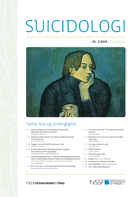Overdoser som selvmord: en fenomenologisk case studie
DOI:
https://doi.org/10.5617/suicidologi.2246Sammendrag
Forskningslitteraturen dokumenterer at noen overdosedødsfall kan være selvmord. Denne studien baserer seg på data fra en gjennomgang av alle registrerte overdosedødsfall i Oslo i perioden 2006–2008. Med utgangspunkt i et case bestående av to av disse dødsfallene som ble vurdert å være selvmord enten på bakgrunn av spesifikke uttalelser eller avskjedsbrev, beskriver den hvordan pårørende og fagfolk erfarte de avdødes livsomstendigheter siste året de levde. Fenomenet overdoser som selvmord belyses også med erfaringer fra andre deltakere i Oslo-gjennomgangen. Gjennom en kvalitativ analyse fremkom fem forhold av betydning for overdoser som selvmord. Forholdene drøftes i lys av to av prinsippene fra Ottawa-erklæringen om å fremme helse. Konklusjonen antyder viktigheten av å innta en deltakerposisjon i forhold til personenes livsomstendigheter og betydningen av å skape håp. In the research literature there is documentation that some overdose deaths may be suicide. This study is based on data from a review of all fatal overdoses in Oslo during the period 2006-2008. Based on a case comprising two of these deaths that were assumed to be suicide, either based on specific statements or suicide notes, we describe how relatives and professionals experienced the deceased persons' life situation during the last year they lived. The phenomenon of overdose as suicide is also illustrated using the experiences of other participants in the Oslo study group. Using qualitative analysis, we found five important elements for overdose as suicide. These are discussed in the light of two of the principles for health promotion in the Ottawa declaration. We suggest the importance of taking on a participant-position in relation to the persons' life contexts and the meaning of creating hope.Referanser
Alstadius, S., & Rossow, I. (2013). Tidsbruk ved behandling av overdoser i Oslo. Sykepleien Forskning; 8 (3): 200–208.
http://dx.doi.org/10.4220/sykepleienf.2013.0097
Beskow, J., Beskow, A.P., & Ehnvall, A. (2005). Suicidalitetens språk. Lund: Studentlitteratur.
Biong, S., Karlsson, B., & Svensson, T. (2008). Metaphors of a shifting sense of self in men recovering from substance abuse and suicidal behavior. J Psychosoc Nurs Ment Health Serv; 46 (4): 35–41.
http://dx.doi.org/10.3928/02793695-20080401-02
PMid:18478807
Biong, S., & Svensson, T. (2009). Bridging the gaps. Experiencing and preventing life-threatening heroin overdoses in men in Oslo. Int J Qual Stud Health and Well-being; 4: 94–105.
http://dx.doi.org/10.1080/17482620902880075
Cullberg, J. (1978). Mennesket i krise og utvikling. Oslo: Aschehoug.
PMid:30992
Darke, S., Degenhardt, L., & Mattick, R. (2007a). Mortality amongst illicit drug users: epidemiology, causes and interventions. Cambrigde: Cambridge University Press.
PMCid:PMC2231629
Darke, S., Duflou, J., & Kaye, S. (2007b). Comparative toxicology of fatal heroin overdose cases and morphine positive homicide victims. Addiction; 102 (11): 1793–1797.
http://dx.doi.org/10.1111/j.1360-0443.2007.01980.x
PMid:17784895
European Monitoring Centre for Drugs and Drug Addiction. (2009). Drug-related deaths and mortality (DRD). Lisbon: European Monitoring Centre for Drugs and Drug Addiction.
European Monitoring Centre for Drugs and Drug Addiction. (2011). Mortality related to drug use in Europe: Public health implications. Luxembourg: Publications Office of the European Union.
Gjersing, L., Biong, S., Ravndal, E., Waal, H., Bramness, J., & Clausen, T. (2011). Dødelige overdoser i Oslo. En helhetlig gjennomgang. Oslo: Senter for rus- og avhengighetsforskning, Universitetet i Oslo.
Hammerlin, Y. (2010). Samfunnets og hverdags-livets lidelsesproduksjon og selvmordsproblematikken. Ansatser til en kritisk refleksjon. Suicidologi; 15 (2): 30–36.
Herrestad, H. & Biong, S. (2010). Relational hopes:
A study of the lived experiences of hope in some
Hickman, M., Carrivick, S., Paterson, S., Hunt, N., Zador, D., Cusick, L., & Henry, J. (2007). London audit of drug-related overdose deaths: characteristics and typology, and implications for prevention and monitoring. Addiction; 102: 317-323.
http://dx.doi.org/10.1111/j.1360-0443.2006.01688.x
PMid:17222287
Husserl, E. (1989). Fenomenologins idé. Göteborg: Daidalos.
Kirkengen, A.L. (2000). Innskrevet i kroppen. Tidsskrift for Den Norske Legeforening; 13: 120–124.
Kvale, S. & Brinkmann, S. (2009). InterView. Introduktion til et håndværk. (2. utgave). København: Hans Reitzels Forlag.
Malterud, K. (2012). Systematic text condensation: A strategy for qualitative analysis. Scand J Public Health; 40: 795–805.
http://dx.doi.org/10.1177/1403494812465030
PMid:23221918
Michel, K., Maltsberger, J.T., Jobes, D.A., Leenaars, A.A., Orbach, I., Stadler, K., Dey, P., Young, R.A., & Valach, L. (2002). Case study. Discovering the Truth in Attempted Suicide. Am J Psychoteraphy; 56 (3): 424–437.
Mills, K.L., Lynskey, M., Teesson, M., Ross, J., & Darke, S. (2005). Post-traumatic stress disorder among people with heroin dependence in the Australian treatment outcome study (AOS): prevalence and correlates. Drug Alcohol Depend; 77 (3): 243–249.
http://dx.doi.org/10.1016/j.drugalcdep.2004.08.016
PMid:15734224
Möller-Leimkühler, A. M. (2003). The gender gap in suicide and premature death or: Why are men so vulnerable? Eur Arch Psychiatry Clin Neurosci; 253(1): 1–8.
http://dx.doi.org/10.1007/s00406-003-0397-6
PMid:12664306
Oyefeso, A., Ghodse, H., Clancy, C., Corkey, J., & Goldfinch, R. (1999). Drug abuse-related mortality: a study of teenage addicts over a 20-year period. Soc Psychiatry and Psychiatr Epidemiol; 34 (8): 437–441.
http://dx.doi.org/10.1007/s001270050166
PMid:10501714
Retterstøl, N., Ekeberg, Ø., & Mehlum, L. (2002). Selvmord– et personlig og samfunnsmessig problem. Oslo: Gyldendal Norsk Forlag.
Scourfield, J. (2005). Suicidal Masculinities. Sociological
Research Online; 10 (2). Lest 01.03.13 (http://www.socresonline.org.uk/10/2/.html).
Skjervheim, H. (1976). Deltaker og tilskodar og andre essays. Oslo: Aschehoug forlag.
Trulsson, K. (2004). The role of social support when giving up a drug abuse: A female perspective. Int J Soc Welfare; 13: 145-157.
http://dx.doi.org/10.1111/j.1369-6866.2004.00308.x
World Health Organisation. (1986). Ottawa charter for health promotion. First international conference on health promotion. Lest 24.10.12 (http://www.who.int/healthpromotion/conferences/previous/ottawa/en/print/html).
Yin, R.K. (2014). Case Study Research. Design and Methods (5h Ed). London: Sage
Nedlastinger
Publisert
Utgave
Seksjon
Lisens
Dette tidsskriftet gir umiddelbar og fri tilgang (Open Access) til tidsskriftets innhold, ut fra det prinsipp at det å gjøre forskning fritt tilgjengelig for allmennheten gir økt global utveksling av kunnskap.
Forfattere som publiserer i dette tidsskriftet aksepterer følgende vilkår:
1. Forfatter beholder opphavsrett til sine verk i henhold til Åndsverkloven, og gir Suicidologi rett til første publisering av et verk.
2. Forfatter kan inngå separate tilleggsavtaler om ikke-eksklusiv distribusjon av den publiserte utgaven av sine artikler (f.eks. levere den inn til et institusjonelt publiseringsarkiv) så lenge Suicidologi blir kreditert som første utgiver.
3. Leseres bruk av tidsskriftet må skje i tråd med Åndsverkloven.


